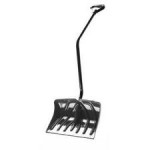By Kevin Perdeaux, CPE
 The ‘ergonomic’ bent-handle shovel is not new to the market, and is a far more popular choice than the traditional straight-handle shovel. However, despite its popularity, why doesn’t the ergonomic shovel render the traditional straight-handle shovel obsolete?
The ‘ergonomic’ bent-handle shovel is not new to the market, and is a far more popular choice than the traditional straight-handle shovel. However, despite its popularity, why doesn’t the ergonomic shovel render the traditional straight-handle shovel obsolete?
The two shovels are designed to provide mechanical advantages in different situations. The bent-handle shovel is designed using the principles of biomechanical stress to the low back for pushing tasks. When push force is applied as the hands move vertically from the hips, either above or below hip level, the off-axis forces create increased strain to the low back. The user applies push forces through the midsection of the trunk to avoid unnecessary low back strain. However, this mechanical advantage is optimal only for pushing the snow, not lifting.
If you have ever used the bent-handle shovel, you may have noticed that the angle of the shaft positions the load such that it is difficult to raise the shovel blade end. When you attempt to lift the shovel, to clear the top of a snow bank for example, the front hand often must lift higher than is required with a traditional handle because of the angle of the shovel shaft. The front hand also bears more of the overall weight due to an inefficient lever created by the handle design. The traditional shovel handle is straight and allows for more optimal hand positioning for easier lifting.
So the next time you are out for a marathon of shoveling, go easy on your back and use the straight-handle shovel for lifting and the bent-handle shovel for pushing. Selecting the right tool for the task is important…even for snow shoveling.
